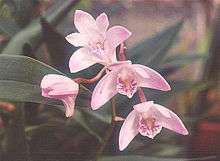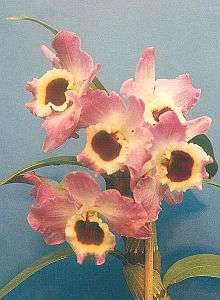Dendrobium
Dendrobium is a genus of mostly epiphytic and lithophytic orchids in the family Orchidaceae. It is a very large genus, containing more than 1,800 species that are found in diverse habitats throughout much of south, east and southeast Asia, including China, Japan, India, the Philippines, Indonesia, Australia, New Guinea, Vietnam and many of the islands of the Pacific. Orchids in this genus have roots that creep over the surface of trees or rocks, rarely having their roots in soil. Up to six leaves develop in a tuft at the tip of a shoot and from one to a large number of flowers are arranged along an unbranched flowering stem. Several attempts have been made to separate Dendrobium into smaller genera, but most have not been accepted by the World Checklist of Selected Plant Families.
.jpg)
| Dendrobium | |
|---|---|
 | |
| Dendrobium kingianum | |
| Scientific classification | |
| Kingdom: | Plantae |
| Clade: | Tracheophytes |
| Clade: | Angiosperms |
| Clade: | Monocots |
| Order: | Asparagales |
| Family: | Orchidaceae |
| Subfamily: | Epidendroideae |
| Tribe: | Dendrobieae |
| Subtribe: | Dendrobiinae |
| Genus: | Dendrobium Sw.[1] |
| Type species | |
| Dendrobium moniliforme (L.) Sw. | |
| Species | |
|
About 1,800; see List of Dendrobium species | |
| Synonyms[2] | |
|
List
| |
Description
Dendrobium species are mostly epiphytic, or lithophytic although a few species are terrestrial. They are sympodial herbs with cylindrical roots usually arising from the base of a pseudobulb. The pseudobulbs, when present, are hard, sometimes cane-like, cylindrical or cone-shaped and more or less covered with the bases of the leaves. There are from one to many leaves arranged in two ranks, the leaves varying in shape from linear to oblong, sometimes cylindrical but never channelled or grooved. They are usually much longer than wide and last for only a single season.[3][4][5]
Between one and a large number of resupinate or non-resupinate flowers are arranged along an unbranched flowering stem and may be short or long-lived. The flowers may be white, green, yellow, or pink to purple, often with contrasting colours in the labellum. The sepals and petals are usually free from and more or less similar to each other but markedly different from the labellum. The labellum is more or less egg-shaped, with the narrower end towards the base and flanks the column. There is often a callus consisting of narrow, parallel ridges, in the centre of the labellum.[3][4][5]
Taxonomy and naming
The genus Dendrobium was first formally described in 1799 by Olof Swartz and the description was published in Nova Acta Regiae Societatis Scientiarum Upsaliensis.[1][6] The name Dendrobium is derived from the ancient Greek words dendron meaning "tree" and bios meaning "life", referring to the epiphytic habit of most species.[6][7]
In 1981, Friedrich Brieger reclassified all terete-leaved dendrobiums from Australia and New Guinea into a new genus, Dockrillia and in 2002 David Jones and Mark Clements separated the genus into smaller genera, including Thelychiton, Tropilis, Vappodes and Winika but all of these genera are regarded as synonyms by the World Checklist of Selected Plant Families.[1]
Distribution and habitat
Orchids in the genus Dendrobium have adapted to a wide variety of habitats, from the high altitudes in the Himalayan mountains to lowland tropical forests and even to the dry climate of the Australian desert.
Uses
Use in horticulture
Dendrobium, is abbreviated as Den. by the Royal Horticultural Society[8]. Some species are in great demand by orchid lovers. This has resulted in numerous varieties and hybrids, such as the noble dendrobium (Den. nobile) breeds, which have greatly extended the range of colors of the original plant from the Himalayas. The flowers of Cuthbertson's dendrobium (Den. cuthbertsonii) have been reported to last up to ten months each.
Many Dendrobium species are known to vigorously remove toluene and xylene from the air.[9]
Several hybrids in this genus have been registered and named after notable persons and institutions:
- Dendrobium Bae Yong-joon
- Dendrobium Sccci 100th Anniversary
- Dendrobium Margaret Thatcher
- Dendrobium Iriana Jokowi
- Dendrobium Joseph Schooling
- Dendrobium Yip Pin Xiu
The grex Dendrobium Berry gx [10] has received the Royal Horticultural Society's Award of Garden Merit.
Medicinal uses

Some Dendrobium species are cultivated as medicinal plants.[11] The noble dendrobium (D. nobile) for example is one of the 50 fundamental herbs used in traditional Chinese medicine, where it is known as shí hú (石斛) or shí hú lán (石斛兰).
The 1889 book 'The Useful Native Plants of Australia records that Dendrobium canaliculatum was called "yamberin" by the Indigenous People of Queensland, Australia and that "The bulbous stems, after being deprived of the old leaves are edible (Thozet)."[12]
In culture
Many species and cultivars of this genus are well-known floral emblems and have been figured in artwork. Among the former are:
- Dendrobium formosum (beautiful giant-flowered dendrobium) – emblem of Ranong Province (Thailand)
- Dendrobium 'Kim il Sung' (Kimilsungia) – emblem of North Korea[13]
- Dendrobium moniliforme (Sekikoku) – emblem of Matsushima, Miyagi (Japan)
- Dendrobium nobile (noble dendrobium) – emblem of Sikkim (India)
- Dendrobium bigibbum (Cooktown orchid, anggrek larat) – emblem of Maluku province (Indonesia) and Queensland (Australia).
- Dendrobium utile[14] (locally known as anggrek serat) – emblem of the Indonesian province of South East Sulawesi
The Cooktown orchid was figured on Australian stamps in 1968 and 1998, and flowers of several Dendrobium greges are depicted on the obverse side of the Singapore Orchid Series currency notes issued between 1967 and 1976:
- Dendrobium Marjorie Ho – S$10[15]
- Dendrobium Shangri-La – S$500[16]
- Dendrobium Kimiyo Kondo – S$1000[17]
The golden-bow dendrobium (D. chrysotoxum), colloquially called fried-egg orchid was one of the species grown by the fictional private detective and orchid fancier Nero Wolfe, and plays a role in The Final Deduction.
Gallery
 Dendrobium Chet's Choice (Dendrobium densiflorum × farmeri), a hybrid belonging to the section Densiflorum (syn. Callista)
Dendrobium Chet's Choice (Dendrobium densiflorum × farmeri), a hybrid belonging to the section Densiflorum (syn. Callista) Dendrobium 'Mini Brown', a hybrid belonging to the section Spatulata
Dendrobium 'Mini Brown', a hybrid belonging to the section Spatulata Painting of a typical Dendrobium by I. V. Passmoore, probably the hybrid Dendrobium Lucky Seven
Painting of a typical Dendrobium by I. V. Passmoore, probably the hybrid Dendrobium Lucky Seven Dendrobium Margaret Thatcher, a hybrid belonging to the section Spatulata
Dendrobium Margaret Thatcher, a hybrid belonging to the section Spatulata_1200.jpg) Dendrobium hybrid belonging to the section Phalaenanthe
Dendrobium hybrid belonging to the section Phalaenanthe_1200.jpg) Dendrobium hybrid
Dendrobium hybrid Dendrobium salaccense
Dendrobium salaccense
References
- "Dendrobium". World Checklist of Selected Plant Families (WCSP). Royal Botanic Gardens, Kew.
- "Dendrobium Sw". Plants of the World Online. Board of Trustees of the Royal Botanic Gardens, Kew. 2017. Retrieved 7 July 2020.
- Zhu, Guanghua; Ji, Zhanhe; Wood, Jeffrey J.; Wood, Howard P. "Dendrobium (石斛属 shi hu shu)". Flora of China. Retrieved 18 January 2019.
- "Genus Dendrobium". Orchids of New Guinea. Retrieved 18 January 2019.
- "Dendrobium". Trin keys. Retrieved 18 January 2019.
- Swartz, Olof (1799). "Dianome Epidendri Generis Linn". Nova Acta Regiae Societatis Scientiarum Upsaliensis. 6: 82. Retrieved 9 November 2018.
- Quattrocchi, Umberto (2012). CRC World Dictionary of Medicinal and Poisonous Plants: Common Names, Scientific Names, Eponyms, synonyms, and Etymology. Boca Raton, Florida: CRC Press. p. 1350. ISBN 9781482250640.
- "Alphabetical list of standard abbreviations of all generic names occurring in current use in orchid hybrid registration as at 31st December 2007" (PDF). Royal Horticultural Society.
- Wolverton (1996)
- "Dendrobium Berry gx". RHS. Retrieved 5 May 2020.
- http://uses.plantnet-project.org/en/Dendrobium_(PROSEA)
- J. H. Maiden (1889). The useful native plants of Australia : Including Tasmania. Turner and Henderson, Sydney.
- Soediono, Noes, Arditti, Joseph and Soediono, Rubismo. Kimilsungia: How an Indonesian Orchid Became a Revered Symbol in the Democratic People’s Republic of Korea After Its Name was Changed. Plant Science Bulletin 75 3 pp. 103-113
- "Dendrobium utile J.J.Sm". Plants of the World Online.
- "Archived copy". Archived from the original on 2008-11-24. Retrieved 2008-11-29.CS1 maint: archived copy as title (link)
- "Archived copy". Archived from the original on 2008-11-24. Retrieved 2008-11-29.CS1 maint: archived copy as title (link)
- "Archived copy". Archived from the original on 2008-11-25. Retrieved 2008-11-29.CS1 maint: archived copy as title (link)
- Clements, M.A. (1989): Catalogue of Australian Orchidaceae. Australian Orchid Research 1: 45–64.
- Wolverton, B.C. (1996): How to Grow Fresh Air. New York: Penguin Books.
- Lavarack, B., Harris, W., Stocker, G. (2006): Dendrobium and Its Relatives. Australia: Simon & Schuster Ltd.
- Burke, J.M., Bayly, M.J., Adams, P.B., Ladiges, P.Y.: (2008) Molecular phylogenetic analysis of Dendrobium (Orchidaceae), with emphasis on the Australian section Dendrocoryne, and implications for generic classification. Australian Systematic Botany 21: 1-14. Abstract
External links
- Generally accepted major sections of the Dendrobium genus

- Multikey System for Identification of Dendrobium species